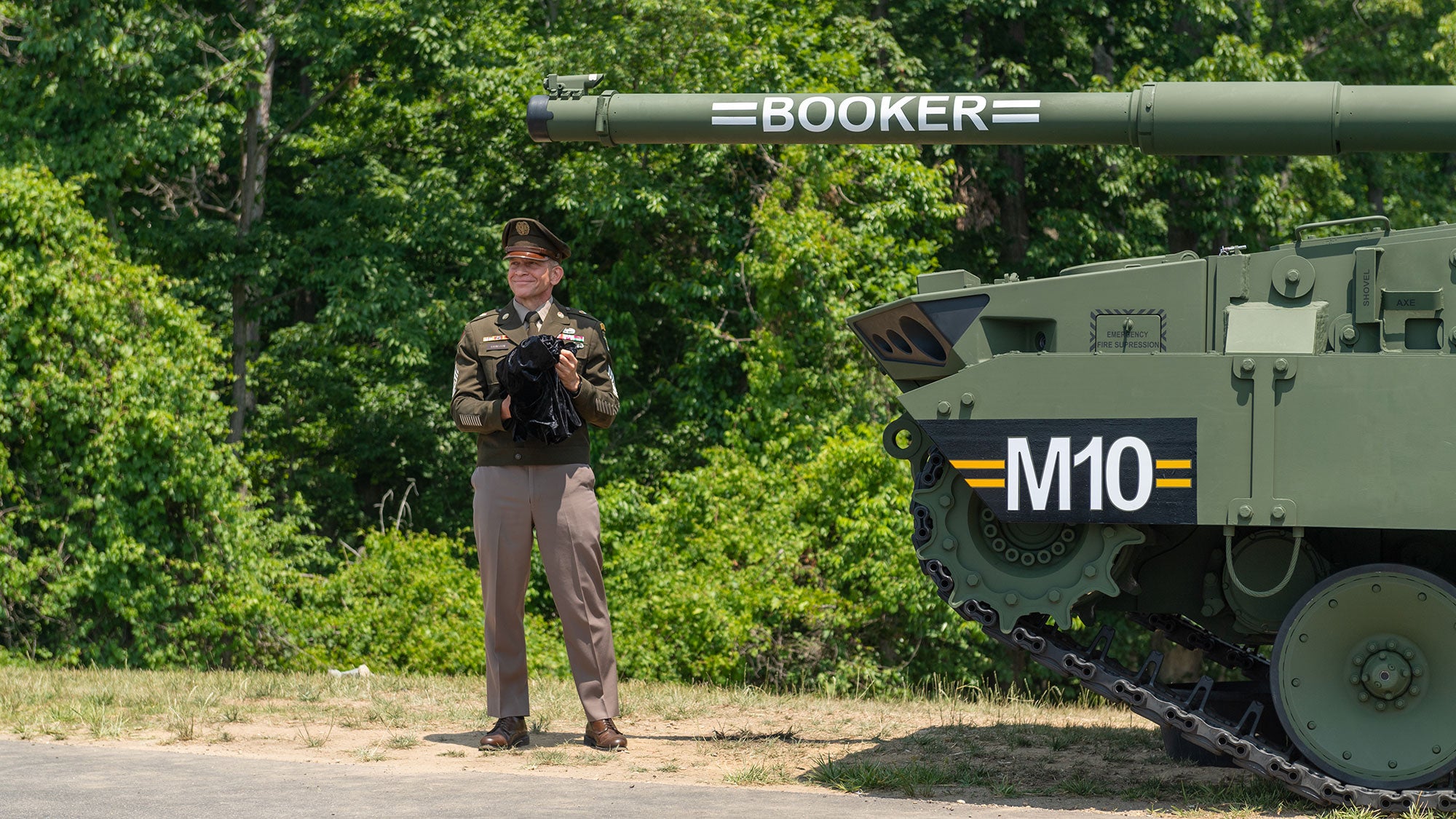
On June 14, the US Army celebrated its 248th year as an institution. Timed in anticipation of that anniversary, the Army also announced the new name for its latest armored turreted military vehicle, initially known and developed with the name MPF, or Mobile Protected Firepower. But the MPF designation is no more; the vehicle is now the M10 Booker.
The Army prefers that the M10 Booker be referred to primarily as a “combat vehicle,” though “infantry assault vehicle” is also used. The vehicle, with a heavy gun and tank-like mobility, is less armored than a main battle tank like an M1 Abrams. It’s designed to go places the Abrams cannot, and to fight against enemy vehicles, defenses, and forces without needing the ultra heavy armor that bulk up battle tanks.
The name announcement took place at the National Museum of the US Army at Fort Belvoir, in Virginia. After a shroud was removed from the vehicle’s 105mm cannon, the barrel revealed the name Booker.

There are two people, both deceased, with the surname Booker who are specifically honored in the naming. The first is Robert D. Booker, a soldier who fought as part of the US Army in North Africa in 1943. Fighting against Axis forces, Robert Booker used his machine gun to defeat one machine gun nest, and then despite receiving fatal injuries, guided his squad as they advanced, actions for which he was awarded a posthumous medal of honor.
The second person honored is Stevon A. Booker, who was among the tank crew leading the April 2003 assault on Baghdad. After the machine gun mounted on the tank failed, he lay prone on top of the tank and guided his unit to defeat anti-tank fire, continuing until he was fatally wounded, actions for which he was awarded a posthumous Distinguished Service Cross.
“The M10 Booker Combat Vehicle is named in [their] honor because it will accomplish what they both did – enabling squads to continue pushing forward through heavy machine-gun fire while protecting our most important weapon system: our Soldiers,” Army Chief of Staff General James McConville said at the Fort Belvoir celebration of the Army’s 248th birthday.
As designed, the vehicle’s mobility and firepower make it a useful tool for clearing uneven terrain, like the contested road to Baghdad or the fields of Tunisia, and then using a powerful gun to destroy fixed defenses and any defenders left crewing them.
“Our Soldiers will now have an infantry assault vehicle in a protected sense with decisive lethality to destroy the threats that took the lives of these two incredible Soldiers,” Doug Bush, the Assistant Secretary of the Army for Acquisition, Logistics and Technology, said in an Army release.
The two namesake Bookers died almost 60 years apart, fighting in wars under drastically different circumstances, technologies, and stakes. In the thick of combat, distinctions between the world-existential crisis of World War II or the war of choice that was Iraq fade away for those in the field. What the Army is designed to do is deliver soldiers to where they’re needed, with the tools on hand to win the day, and both Bookers died protecting their comrades-at-arms.
This is work that can be done by a tank, but the Army is explicit that this is not a task that can fall to a light tank. Maj. Gen. Glenn Dean, Program Executive Officer for Ground Combat Systems, told Task & Purpose, “The historic use of ‘light tank’ is to perform reconnaissance functions, and this is not a reconnaissance vehicle, it’s an assault gun. Historically, it’s not actually a mission match, even though it looks like, feels like, and smells like [a tank].” (Task & Purpose is owned by Recurrent Ventures, PopSci’s parent company.)
The Army already had one mobile not-quite-tank with a high powered gun for similar purposes, the Stryker Mobile Gun System. That vehicle, armored and turreted but with eight wheels instead of treads, is one the Army is actively divesting from. The new M10 Booker will fill a similar role, in a body designed for the wars of the 21st century.
Some of those threats will feel familiar. Machine guns remain an efficient, durable, lethal tool for all militaries and insurgencies alike, and stopping one with force is a task well-suited to the M10 not-a-tank’s big gun. While the M10 is not light by any definition, its 42 tons is a significant drop down from the over 70 tons of the Abrams. That helps the M10s be delivered, two at a time, by C-17 cargo jets, making it armor that can follow infantry from a secured airfield.
In total, the Army plans to acquire 504 of the M10 Bookers, priced at around $13 million apiece. While new counter-tank tools make armored assaults harder, and despite the military theorists who proclaimed the death of the tank in April 2022, the need for militaries to advance under fire persists. That makes tanks and tank-like vehicles a durable feature of modern armies, and while the Booker is named after metal awardees, the point of the machine is to win battles without needing such heroics.
The post The Army’s new 42-ton assault vehicle has a compelling backstory appeared first on Popular Science.
Articles may contain affiliate links which enable us to share in the revenue of any purchases made.
from | Popular Science https://ift.tt/9UX5CpO



0 Comments